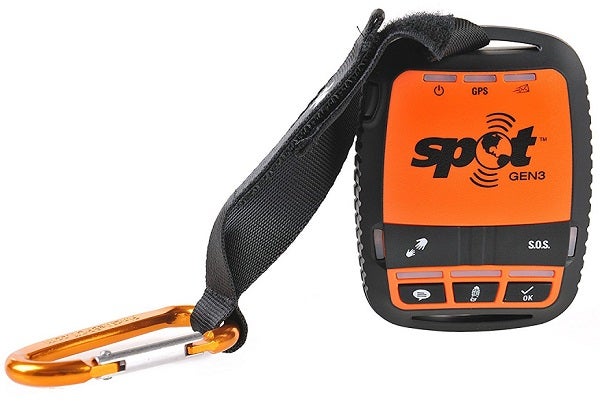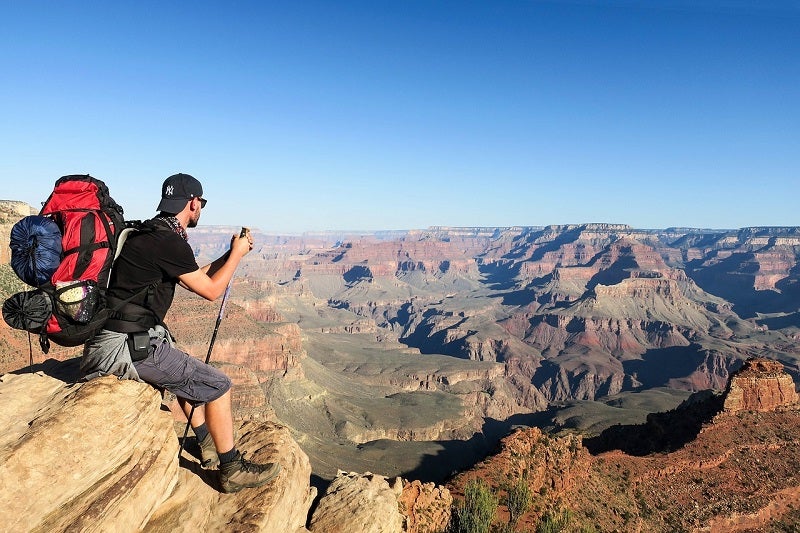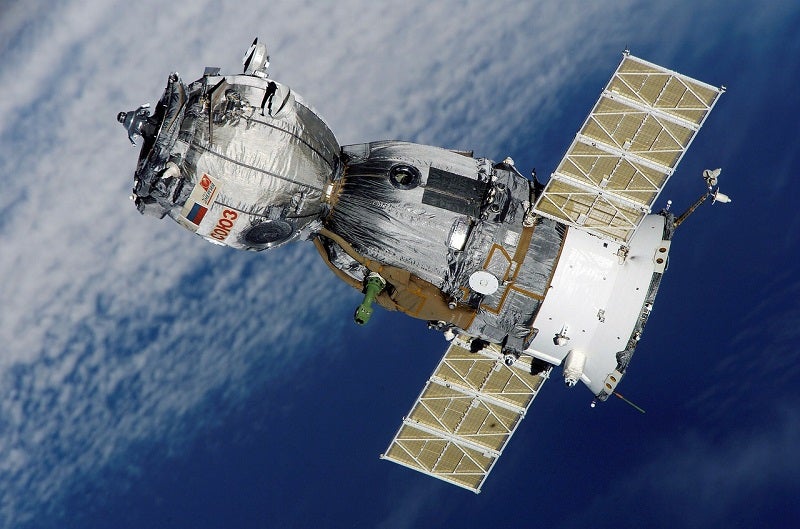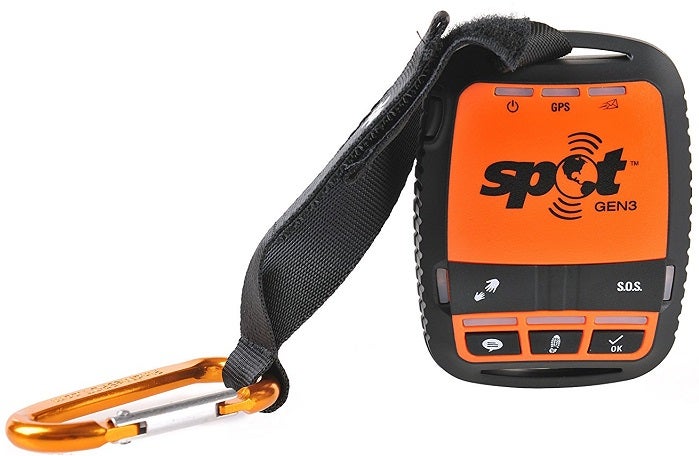
Our Editors independently research, test, and rate what we feel are the best products. We use affiliate links and may receive a small commission on purchases.
Personal locator beacons are the safety net of backcountry travel. They’re simple electronic devices, usually with sealed mechanisms, that are meant to be used a single time.
When you use a PLB it’s a life or death emergency that will result in a full scale rescue mobilization. Using a personal locator beacon isn’t like sending a text to your mom.
These devices directly access an emergency network of rescue personnel to save lives in true emergencies.
It’s worth mentioning that in the last few years backcountry messenger devices have become more popular. These are satellite powered electronics that boost your cell phone’s capabilities or send messages on their own.
Best PLBs & Satellite Communicators
For more of my hiking recommendations, have a look through these popular Outside Pursuits guide links: Hiking Watches, Handheld Hiking GPS’s, Solar Chargers.
Quick Answer: The 6 Best Rated Personal Locator Beacons
- ACR ResQlink+ Personal Locator Beacon
- McMurdo FAST FIND 220 PLB
- Garmin Inreach Explorer+
- Garmin inReach SE+, Handheld Satellite Communicator
- SPOT Satellite GPS Messenger
- RESCUEME PLB1 Personal Locator Beacon
We’ll cover the differences between a true personal locator beacon and some of the modern messaging devices in this article. I’m going to show you a few of the top rated personal locator beacons available to choose from.
Personal Locator Beacon Reviews
#1 ACR ResQlink+ PLB
This Personal Locator Beacon (PLB) is ready to go right out of the box. ACR has been making PLBs for years and they’re by far the most common PLB used in backcountry situations around the United States.
I’ve carried these before on several trips and when leading groups in the wilderness.
There’s nothing particularly fancy about them. They’re foolproof, easy to use, and quick to learn. Even if you forget how to use them, there are simple instructions on the PLB that walk you through a couple quick steps.
This PLB should be registered with the NOAA in the US who will be the first to receive any signals from the device. Not in the US? Check here for info. They will then initiate the proper rescue for you.
Your PLB must be registered after purchasing – it’s an important and legal step in using the beacon.
Remember that using this beacon will initiate a full scale rescue and you may be held liable to pay for some or all of the rescue costs in certain situations and locations.
These rescues often cost $20,000 or more! They’re only to be used in life and death emergencies. If your looking for a PLB, the ACS ResQLink is the best personal locator beacon, hands down!
#2 McMurdo FAST FIND 220 PLB
The McMurdo FAST FIND 220 is made to be completely waterproof to a depth of 10 meters, but needs a buoyancy pouch to float which should be included with the PLB. If you do a lot of offshore fishing, sailing, or boating one of these wouldn’t hurt in the boat!
Much like the ResQlink+ it’s easy to use and foolproof. The GPS receiver is clearly marked with “GPS zone, do not obstruct”. Even in the most frightening situations, you’ll be able to easily remember what to do with the device.
There is an LED SOS light built into the device to help aid night rescues and visibility. The built-in concealed antenna automatically deploys when in use, and the battery will operate continuously for a minimum of 24 hours.
Its body is small, compact and lightweight, so you can carry it with you at all times whether you’re traveling by land, sea or air.
#3 Garmin Inreach Explorer+
As satellite messaging and emergency devices become more popular, Garmin has carved out a corner of the market. Known for their GPS devices, the Explorer+ is a communicator and rescue device.
Combine Garmin’s legendary GPS with two way messaging and SOS capabilities and you get the Explorer+.
You can send messages to contacts, view your location and navigate via GPS, or hit the emergency button for a magical evacuation coordinated by Garmin’s for-profit rescue center.
I like that you can pair it with your phone to unlock advanced features such as downloadable maps, charts, and aerial images.
Like the SPOT devices you can track and transmit your location with family and friends. It has a handy data usage tracking features.
Why? Cause you’ll have to pay a monthly subscription.
That brings me to my final point. This device really only makes sense for those who are out in remote locations nearly every weekend.
You’ll be paying a pretty penny to have your device subscription active and it just doesn’t make sense if you’re only going to use it once a year.
Best for very active explorers of remote areas who want bleeding edge tech.
#4 Garmin inReach SE+, Handheld Satellite Communicator with GPS
DeLorme was a major player in the satellite tech space but have since been bought out by Garmin. They’re known for great GPS systems and used to compete heavily with Garmin and TomTom for market space in the exploration world.
It’s essentially the same device but now Garmin has put their name on this popular satellite communicator.
That’s not to say they’re any worse! Garmin lets you communicate with two way messaging, location sharing, and other advanced features with the InReach SE.
You can send and receive messages up to 160 characters – like old school cell phones. These can be send along with GPS coordinates to phone numbers or email address.
This feature is particularly helpful if you’re in need of help but don’t want to trigger a full scale rescue. Jonesing for some of Grandma’s cookies? Send her a text with your coordinates and she can fly you in some cookies with her new drone!
I love that you can set the device to continuously send out your location to a cloud based website where friends and family can check your progress.
Set the device to mark your location once per day and your family can monitor your progress toward the next checkpoint and they’ll know if you go off course deep in the wilderness!
Best for advanced communication and tracking.
#5 SPOT 3 Satellite GPS Messenger
SPOT was one of the early players in advanced satellite based communication and rescue devices for personal use. Depending on your device subscription level you can do all sorts of fun and helpful location and communication.
SPOT 3 is the most recent iteration of these popular satellite messengers.
With the ability to send satellite based GPS tracking info at intervals or based on motion, you can keep an remotely updated map of your location viewable by family and friends. Just like the DeLore SE!
Unlike the DeLorme and the Garmin, the SPOT doesn’t have a viewable screen or other features. You’ll only be able to use this for simple communication and emergencies.
It’s a bit more affordable but you lose GPS navigation capabilities and other advanced functions.
However, with the simpler demands of this device, you can transmit your location or use the SOS features for a lot longer on just one set of batteries.
With no screen or advanced computing capabilities the SPOT is much lighter on battery use than the Garmin or DeLorme. Something to consider on long trips.
Best for long remote trips with a need for battery conservation.
#6 RESCUEME PLB1 Personal Locator Beacon
Another marine programmed PLB for location and rescue in the waterways of the United States. As with all devices you’ll need to register with NOAA.
You can use the device outside the US but it will first contact a US registered NOAA emergency center for transmission to the proper authorities, wherever you may be.
The outside of the device is clearly marked with instructions for use. You’ll be able to easily understand and operate the rescue capabilities of the device in any situation.
I wish they would have molded the instructions into the plastic instead of using stickers though, as this might help in the odd chance any stickers are destroyed or peel off in extreme circumstances.
According to the manufacturer there are no charges to use the COSPAS SARSAT system with this device.
In a world where everything is becoming privatized and expensive, it’s good to know you can call for rescue with this device free of charge. I still wouldn’t use it for a stubbed toe, though.
My biggest criticism of the device is user complaints about the small locator device slipping out of its floating case. If true, this is a major oversight as the device itself should float with or without a case.
Having your PLB sink to the bottom of the ocean would just ruin your day.
PLB & Satellite Messenger Comparison Table
| Function | GPS Mapping | Marine Use | Strobe | Subscription Required | ||
|---|---|---|---|---|---|---|
| ACR ResQlink+ PLB | PLB | Yes | Yes | Yes | No | |
| McMurdo FAST FIND 220 Personal Locator Beacon | PLB | Yes | Yes | Yes | No | |
| Garmin Inreach Explorer+ | Messaging | Yes | No | No | Yes | |
| Garmin inReach SE+, Satellite Communicator | Messaging | Yes | No | No | Yes | |
| SPOT 3 GPS Messenger | Messaging | No | No | No | Yes | |
| RESCUEME PLB1 | PLB | No | Yes | Yes | No |
How to Choose the Best Personal Locator Beacon for You
Often the differences between PLB’s are relatively minute. Choosing between models can seem difficult or trivial so let’s break down the real nitty gritty.
If you’ve decided that you’ll need a Personal Locator Beacon, the next step is to choose between some of the models available. So how can you choose a PLB for your needs?
What makes each PLB different? I’m going to help you learn what to look for when you buy your next PLB.
Understanding Satellite Networks
Prepare yourself for a quick dive into the world of commercialized space objects! In order for PLB’s to know where you are, they need to work from any location in any weather at any time.
Your plain old vanilla cell phone network just isn’t going to cut it here. We need something with grit. Something that spans the network….
Enter the satellite networks. Each PLB is programmed to work with different types of satellite networks and there are essentially two different kinds.
COSPAS and SARSAT – are a network of orbiting satellites practically controlled by the military. They’re by far the most comprehensive network of location satellites in orbit today.
These control EPIRBs (naval and marine locators) and PLBs. More devices may be added at any time and device access to this network is heavily restricted.
Globalstar and Iridium – are satellite networks owned by private companies that grant access at nosebleed prices. Manufacturers can pay for access to these networks and then sell their devices to you at a cost – resulting in profit for everyone.
Globalstar controls a network of satellites that cover nearly every region of the earth except remote parts of Africa and the poles.
If you want to be located near the North or South Pole you’ll want to avoid SPOT devices which rely on this constellation of satellites.
Garmin devices are backed by the Iridium satellite network. This constellation of satellites contains a few more satellites in total but still receives spotty coverage in some areas. It does, however, cover the poles.
When in doubt, contact the manufacturer of your device or read their support website to understand the network and coverage of your device.
Device Types
In the world of PLBs there are a few variants that are important to understand. You don’t want to use the wrong one in the wrong area or for the wrong reasons!
PLB’s
Are personal locator beacons. These devices send out two signals when you decide to hit the emergency button. One signal beams up to the satellites in orbit miles above your head.
These satellites locate your coordinates and alert rescue teams. At the same time the PLB sends out an emergency radio signal that transmits to rescuers as they near your location.
These devices do not require a subscription to operate!
This one-two punch is more reliable and accurate than any other emergency locator system currently for absolute worst-case scenarios!
SEND
Devices are two communication devices that rely on satellite networks to communicate. These communicate with rescue centers operated by for-profit companies that will then coordinate with rescue teams to get your butt out of the emergency situation.
Unlike PLBs, SPOT messengers and other SEND devices usually allow more thorough communication. They may send you confirmation that rescue is coming. You can often transmit in depth messages or relay text messages with rescuers.
The drawbacks of SEND devices are that their signals tend to be much weaker. With obstructed skies, tree cover, or even terrible weather a GPS lock may fail.
Even if the SOS communication is received, rescuers won’t have the additional radio frequency emitted by a PLB to lock onto.
Which to choose?
In terms of raw emergency rescue power, you’ll want a PLB. If your only need is a one-time use emergency rescue signal with maximum reliability then go with a PLB.
SEND devices are less reliable but allow sometimes for two-way communication or advanced features.
Conclusion
If you’re looking for a device that simply and reliably transmits your location for the sole purpose of a rescue, use a PLB. It’s really that simple. They’re powerful, reliable, and tested devices.
For those looking for advanced features like GPS navigation, two way communication, and messaging a SEND device like the SPOT, Garmin, or DeLorme is a great choice.
These devices allow for helpful daily navigation and communications in all situations – not just life or limb emergencies.
How We Researched
To come up with the top personal locator beacons we researched a variety of sources for reviews such as REI, Bass Pro Shops, Cabelas and Backcountry along with our own personal experience.
We also consulted online magazines for product research and reviews to get as much unbiased information as we could. To help weed out fake reviews we used Fakespot.com to make sure we only looked at genuine reviews.
With so much quality gear available, we had to narrow it down based on what we felt were the best options for the price. The author, Casey Fiedler has been leading backpacking trips for over a decade in his native state of Michigan.
To help narrow down the selection he used his personal experience along with recommendations from fellow guides and outfitters.
After extensive research, we came up with our list to help you choose the right one for you.
Sources
I hope this guide was helpful for finding the best PLB to fit your needs. If you want to comment or recommend a PLB I didn’t include, please use my contact form to get in touch.





Thanks for talking about some of your favorite personal locator beacons! One thing that I thought was neat was that there is nothing really fancy about them but they are foolproof and easy to use. My son wants to go camping eventually, and I think that getting something like this or a GPS would help us stay safe. Thanks!
Hope you found one you liked, good luck!
Few things to note.
PLB’s can be located (roughly) even without a GPS lock. It’s possible to triangulate their location to within a few square miles. SPOT\similar devices cannot do this, if they don’t have a GPS lock they don’t have a clue where you are.
While the tracking features of the SPOT\similar are neat and useful, reception is not always the greatest. It’s entirely possible for someone to fall off the map for hours or even a day without there being any emergency. Calling S&R because the tracker didn’t respond for a hour or two probably isn’t a good idea.
If you are relying on a satphone network device, it’s a good idea to be aware of it’s limitations before counting on it, while i’m no expert i know certain types of terrain pose issues (cliff’s are one i’ve often heard, so probably not a great device for climbers)
Hi William, thanks for the input on PLBs.
Rich
Delorme (Inreach) was bought by Garmin. The Garmin Inreach Explorer+ is the successor to the Delorme Inreach Explorer. The Inreach SE compared to the Explorer(+) is without the tracking and mapping feature, so not good for tracking and navigation.
The article is dated “September 13, 2018” so the Inreach Mini released in May is a must to be in here.
Its on on my “to-do” list
Changes in the reviews have been made.
PLB’s are not automatically registered, although if activated before it is registered, it will still illicit a response from the appropriate search and rescue/recovery organization, world wide. And when registered by the user, it is registered with NOAA, National Oceanographic and Atmospheric Administration, not the USCG.
Link attached:
https://www.sarsat.noaa.gov/beacon.html
please note your comparison table is incorrect, the RescueMe PLB1 does have a strobe see here for details http://oceansignal.com/products/plb1/
David,
You are correct. I have modified the table to reflect that it does have a strobe.
I found the RESCUEME PLB1 to be the most interesting, but it seems to be for marine use. Can it also be used by pilots flying within U.S. overland territory? Thanks